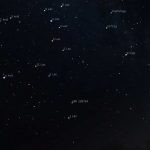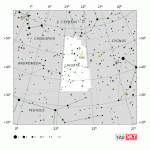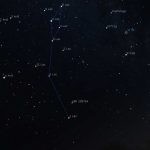| Meaning: | The Lizard | Print out the star map from Sky and Telescope
Things to look for: Messier objects: Note: [x.x] indicates visual magnitude |
|
| Pronunciation: | luh sir’ tuh | ||
| Associated Asterisms: | The Little W | ||
| % of the sky: | 0.49% | ||
| Visible Stars: | 23 stars brighter than magnitude 5.5 |

Lacerta is a small faint constellation nestled tightly between Cygnus, Pegasus, Andromeda, Cepheus and Cassiopeia. It was original introduced by Johannes Hevelius in 1687 and was included in the IAU’s rationalisation in 1922.

At 68th, it is not the smallest of the 88 but it sits between constellations more generously assigned space so can be overlooked. The head of the lizard can easily be found using Cassiopeia and making a line from Navi through Caph towards Cygnus. About halfway is Lacerta.

One notable thing about Lacerta is that five of its brightest stars in the head of the lizard make up a small copy of the famous W of Cassiopeia. The stars forming the W are β Lac, α Lac, 4 Lac, 5 Lac and 2 Lac; the brightest α is only magnitude 3.75.
It is a circumpolar constellation for people in the UK and the head of the Lizard sits within the Milky Way. This makes it an ok location to use a mid magnification on a wide aperture scope and just be awed by the enormity of the Galaxy on a dark night but it is quite poorly served in terms of objects visible with amateur telescopes. There are the open clusters NGC 7209 and 7243 just dimmer than magnitude 6 and various NGC galaxies starting around magnitude 12. IC 5217 is a planetary nebula and sits between 4 Lac and β Lac and has a magnitude of 11.7. It is small at only 15″ and so is perhaps just a 15th the width of M57 in Lyra; however, if you can crank the magnification up on a dark still night, you might be rewarded.

Lacerta lacks any significant age in Western astronomy and so there is no attached mythology. Originally name Stellio are a small, spotted Mediterranean newt. The name Lacerta refers to the Latin genus of similar lizards.

